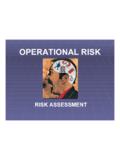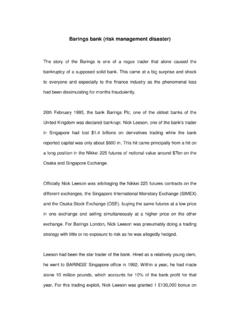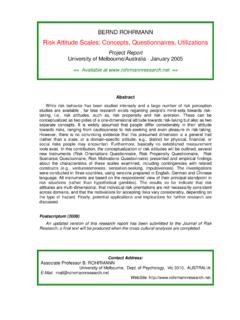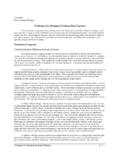Transcription of 17R-97: Cost Estimate Classification System - Anvari.Net
1 Copyright 2003 AACE, Inc. AACE International Recommended Practices AACE International Recommended Practice No. 17R-97 cost Estimate Classification System TCM Framework: cost Estimating and Budgeting Acknowledgments: Peter Christensen, CCE (Author) Larry R. Dysert, CCC (Author) Jennifer Bates, CCE Dorothy J. Burton Robert C. Creese, PE CCE John K. Hollmann, PE CCE Kenneth K. Humphreys, PE CCE Donald F. McDonald, Jr. PE CCE C. Arthur Miller Bernard A. Pietlock, CCC Wesley R. Querns, CCE Don L.
2 Short, II Copyright 2003 AACE, Inc. AACE International Recommended Practices AACE International Recommended Practice No. 17R-97 cost Estimate Classification System TCM Framework: cost Estimating and Budgeting August 12, 1997 PURPOSE As a recommended practice of AACE International, the cost Estimate Classification System provides guidelines for applying the general principles of Estimate Classification to asset project cost estimates . Asset project cost estimates typically involve estimates for capital investment, and exclude operating and life-cycle evaluations.
3 The cost Estimate Classification System maps the phases and stages of asset cost estimating together with a generic maturity and quality matrix that can be applied across a wide variety of industries. This guideline and its addenda have been developed in a way that: provides common understanding of the concepts involved with classifying project cost estimates , regardless of the type of enterprise or industry the estimates relate to; fully defines and correlates the major characteristics used in classifying cost estimates so that enterprises may unambiguously determine how their practices compare to the guidelines; uses degree of project definition as the primary characteristic to categorize Estimate classes.
4 And reflects generally-accepted practices in the cost engineering profession. An intent of the guidelines is to improve communication among all of the stakeholders involved with preparing, evaluating, and using project cost estimates . The various parties that use project cost estimates often misinterpret the quality and value of the information available to prepare cost estimates , the various methods employed during the estimating process, the accuracy level expected from estimates , and the level of risk associated with estimates . This Classification guideline is intended to help those involved with project estimates to avoid misinterpretation of the various classes of cost estimates and to avoid their misapplication and misrepresentation.
5 Improving communications about Estimate classifications reduces business costs and project cycle times by avoiding inappropriate business and financial decisions, actions, delays, or disputes caused by misunderstandings of cost estimates and what they are expected to represent. This document is intended to provide a guideline, not a standard. It is understood that each enterprise may have its own project and estimating processes and terminology, and may classify estimates in particular ways. This guideline provides a generic and generally-acceptable Classification System that can be used as a basis to compare against.
6 If an enterprise or organization has not yet formally documented its own Estimate Classification scheme, then this guideline may provide an acceptable starting point. INTRODUCTION An AACE International guideline for cost Estimate Classification for the process industries was developed in the late 1960s or early 1970s, and a simplified version was adopted as an ANSI Standard in 1972. Those guidelines and standards enjoy reasonably broad acceptance within the engineering and construction communities and within the process industries. This recommended practice guide and its addenda improves upon these standards by: 1.
7 Providing a Classification method applicable across all industries; and 2. unambiguously identifying, cross-referencing, benchmarking, and empirically evaluating the multiple characteristics related to the class of cost Estimate . This guideline is intended to provide a generic methodology for the Classification of project cost estimates in any industry, and will be supplemented with addenda that will provide extensions and additional detail for specific industries. Copyright 2003 AACE, Inc. AACE International Recommended Practices 2 of 6 cost Estimate Classification System August 12, 1997 Classification METHODOLOGY There are numerous characteristics that can be used to categorize cost Estimate types.
8 The most significant of these are degree of project definition, end usage of the Estimate , estimating methodology, and the effort and time needed to prepare the Estimate . The primary characteristic used in this guideline to define the Classification category is the degree of project definition. The other characteristics are secondary. Categorizing cost estimates by degree of project definition is in keeping with the AACE International philosophy of Total cost Management, which is a quality-driven process applied during the entire project life cycle. The discrete levels of project definition used for classifying estimates correspond to the typical phases and gates of evaluation, authorization, and execution often used by project stakeholders during a project life cycle.
9 Five cost Estimate classes have been established. While the level of project definition is a continuous spectrum, it was determined from benchmarking industry practices that three to five discrete categories are commonly used. Five categories are established in this guideline as it is easier to simplify by combining categories than it is to arbitrarily split a standard. The Estimate class designations are labeled Class 1, 2, 3, 4, and 5. A Class 5 Estimate is based upon the lowest level of project definition, and a Class 1 Estimate is closest to full project definition and maturity. This arbitrary countdown approach considers that estimating is a process whereby successive estimates are prepared until a final Estimate closes the process.
10 Notes: [a] If the range index value of "1" represents +10/-5%, then an index value of 10 represents +100/-50%. [b] If the cost index value of "1" represents of project costs, then an index value of 100 represents Figure 1 Generic cost Estimate Classification Matrix Estimate CLASSC lass 50% to 2%Screening orFeasibilityStochastic orJudgment4 to 201 Class 41% to 15%Concept Study orFeasibilityPrimarilyStochastic3 to 122 to 4 Class 310% to 40%Budget,Authorization, orControlMixed, butPrimarilyStochastic2 to 63 to 10 Class 230% to 70%Control or Bid/TenderPrimarilyDeterministic1 to 35 to 20 Class 150% to 100%Check Estimate orBid/TenderDeterministic110 to 100 PrimaryCharacteristicSecondary CharacteristicEND USAGET ypical purposeof estimateMETHODOLOGYT ypical estimatingmethodEXPECTEDACCURACYRANGET ypical +/- range relative to best index of 1 [a]PREPARATIONEFFORTT ypical degreeof effort relativeto least costindex of 1 [b]LEVEL OFPROJECTDEFINITIONE xpressed as % ofcomplete definition Copyright 2003 AACE, Inc.











